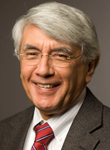Torres trains international veterinarians with USDA

Dr. Alfonso Torres, a veterinary professor and associate dean of public policy at Cornell’s College of Veterinary Medicine, is co-leading, with veterinary scientists from the U.S. Department of Agriculture (USDA), the charge to increase the number of veterinarians around the world who are familiar with highly infectious animal diseases that could threaten the health of livestock and poultry globally.
Animal agriculture is an important part of people’s livelihoods and the economy across the globe, with more than 19 billion chickens, 1.5 billion cows, 1 billion sheep and 1 billion pigs worldwide. The world is growing increasingly interconnected, with greater international travel and larger volumes of international trade. A number of highly contagious animal diseases have the capacity to cause outbreaks that could quickly move across the world and bring with them devastating consequences, says Torres.
Working with the USDA’s Animal and Plant Health Inspection Service (APHIS), which protects the health of America’s livestock and poultry, he is offering classes for veterinarians from across the globe to enhance their abilities to recognize and diagnosis animal disease outbreaks as they arise. The trainings, which focus on about 30 of the most serious animal diseases, enhance a global network of highly trained veterinarians who can work collectively, readily identifying and controlling these diseases, and in turn, minimizing damage to animal agriculture and people’s livelihoods.
The “International Transboundary Animal Disease Course” is just one of five courses offered by APHIS each year at the Plum Island Animal Disease Center in New York to train U.S. and international veterinarians on foreign animal diseases. The courses are held at the remote Plum Island facility because they involve inoculating animals with 10 severe foreign animal diseases, including foot-and-mouth disease.
The course demonstrates critical clinical and pathological manifestations that are key in the early recognition of these serious diseases in the field, Torres says.
Being able to recognize and respond early is key to successfully combating these diseases, says Torres. The longer it takes to contain a disease, the chance of it spreading to new areas increases. And when dealing with the control and eradication of these types of diseases, stopping or severely limiting animal movements can have a devastating effect on trade and the economy in an affected region or country.
“The unique opportunity of having veterinary participants from several countries in the same course creates linkages of international collaboration that help promote a sense of global responsibility in the fight for the prevention and control of very serious animal diseases,” Torres says.
Media Contact
Get Cornell news delivered right to your inbox.
Subscribe